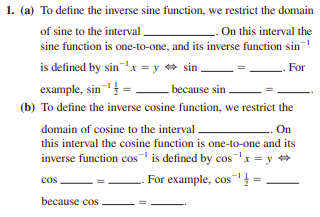1. (a) To define the inverse sine function, we restrict the domain of sine to the interval . sine function is one-to-one, and its inverse function sin is defined by sinx = y + sin , example, sin = On this interval the For because sin (b) To define the inverse cosine function, we restrict the domain of cosine to the interval On this interval the cosine function is one-to-one and its inverse function cos is defined by cosx = y + For example, cos cos because cos
1. (a) To define the inverse sine function, we restrict the domain of sine to the interval . sine function is one-to-one, and its inverse function sin is defined by sinx = y + sin , example, sin = On this interval the For because sin (b) To define the inverse cosine function, we restrict the domain of cosine to the interval On this interval the cosine function is one-to-one and its inverse function cos is defined by cosx = y + For example, cos cos because cos
Algebra & Trigonometry with Analytic Geometry
13th Edition
ISBN:9781133382119
Author:Swokowski
Publisher:Swokowski
Chapter7: Analytic Trigonometry
Section7.6: The Inverse Trigonometric Functions
Problem 65E
Related questions
Question

Transcribed Image Text:1. (a) To define the inverse sine function, we restrict the domain
of sine to the interval .
sine function is one-to-one, and its inverse function sin
is defined by sinx = y + sin ,
example, sin =
On this interval the
For
because sin
(b) To define the inverse cosine function, we restrict the
domain of cosine to the interval
On
this interval the cosine function is one-to-one and its
inverse function cos is defined by cosx = y +
For example, cos
cos
because cos
Expert Solution
This question has been solved!
Explore an expertly crafted, step-by-step solution for a thorough understanding of key concepts.
This is a popular solution!
Trending now
This is a popular solution!
Step by step
Solved in 2 steps

Recommended textbooks for you

Algebra & Trigonometry with Analytic Geometry
Algebra
ISBN:
9781133382119
Author:
Swokowski
Publisher:
Cengage

Algebra & Trigonometry with Analytic Geometry
Algebra
ISBN:
9781133382119
Author:
Swokowski
Publisher:
Cengage